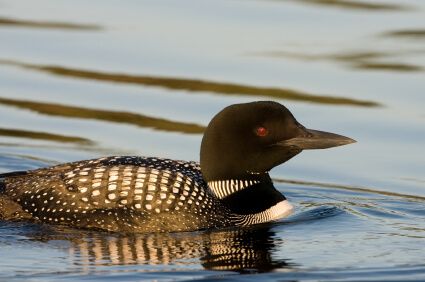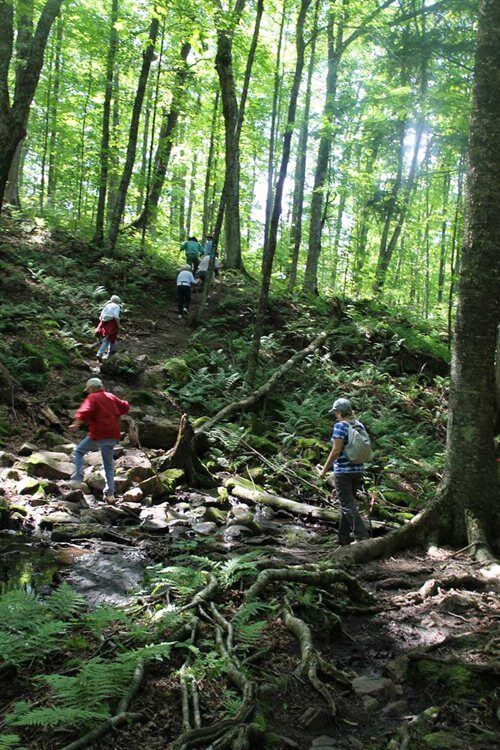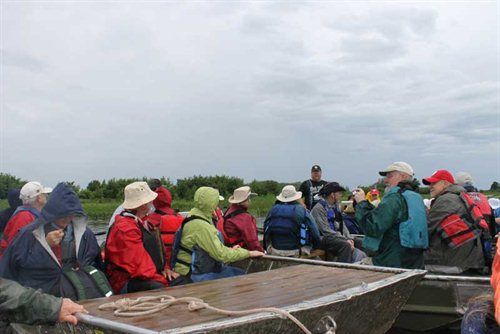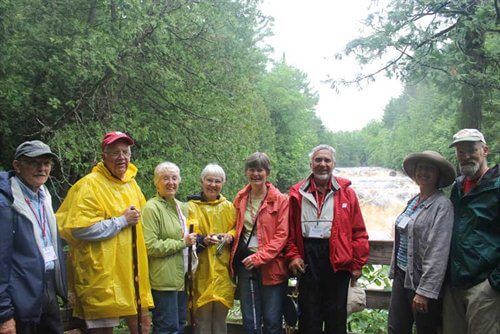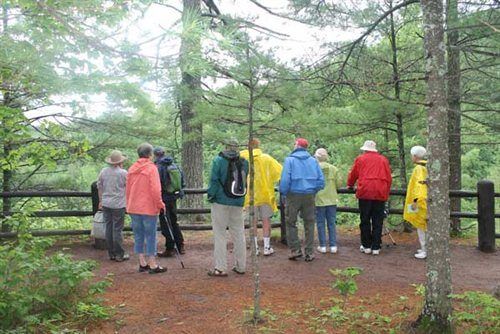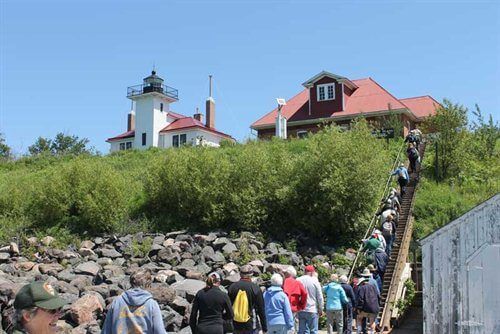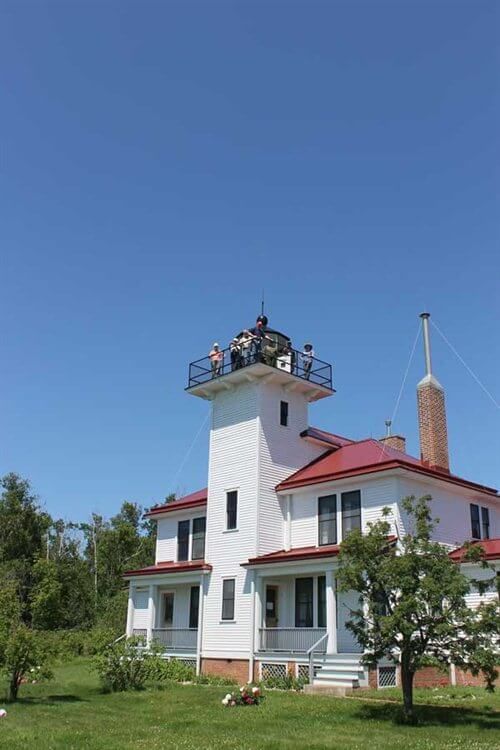Mary Besenjak Motiff ’92 and her family moved from Green Bay to Bayfield, Wis., seven years ago, calling it the “perfect place to end up.”
“We call ourselves Wisconsin’s Crown Jewel,” laughs Motiff, who serves as director of tourism and recreation for Bayfield County. “There’s an indescribable feeling you get when you visit: a connection to the lake, the beauty surrounding you.”
Jason Maloney ’82, ’83 agrees: “There’s nothing like this area,” he says. “The combination of the great outdoors, the lake, the wonderful aspects of nature. Everyone here is nice and makes you feel at home.”
Bayfield County sits nestled along Chequamegon Bay in a southwestern corner of Lake Superior, more than 300 miles north of Madison. But the area is home to as many Badgers as there are B&B’s, boaters and bike trails.
Maloney, who graduated with degrees in history and education, serves as director of the Northern Great Lakes Visitor Center, the gateway to 3,700 square feet of Wisconsin wilderness for up to 160,000 guests every year.
Each day, alumni such as Maloney and Motiff put what they learned at UW-Madison to work: promoting tourism and culture, teaching residents and travelers alike about the wonders of this wild corner of Wisconsin, and crusading to preserve the Northwoods.
Not Your Typical Northwoods

“Out of anywhere in the world, Wisconsin is THE place where tourism and nature come together for visitors,” Motiff explains.
There is little downtime for Motiff, who manages tourism marketing, the county fair and coordination of the county’s complex trail systems. She says that while the visitor population booms in the summer — thanks to seasonal home owners and Apostle Islands National Park sight-seers — tourists also head north in the fall to see the changing leaves and sample from local berry farms and orchards, and in winter to take advantage of hundreds of miles of snowmobile and cross-country ski trails.
As a UW-Madison student, Motiff gravitated toward a major in zoology after taking just a few courses in environmental studies, including an entomological field study of prairie chickens and waking up before dawn to bird-watch.
“I use my background in science to talk about the area in a way that’s a little more meaningful when visitors have questions, or when I’m showing travel writers around,” she says. “In addition to the outdoor experience, we have theaters, art galleries and wonderful restaurants that serve fresh, local food. Bayfield is not your typical Northwoods.”
Hands-On Education: Learning by Doing

“The name doesn’t even begin to explain what we have to offer here,” Jason Maloney says of the Northern Great Lakes Visitor Center, located in Ashland, Wis. Outdoors, visitors can climb a five-story viewing tower, walk two miles of trail or explore the children’s discovery area. Indoors, visitors find theaters, classrooms and exhibit space.
The center, part of the Chequamegon-Nicolet National Forest, opened in 1998 and is run by a partnership of federal, state and local agencies, both public and private — cooperation that Maloney calls a “cutting-edge example of good government.”
Despite their different missions, Maloney says the agencies work together for the common good of economic growth and sustainability: “Whether visitors are asking where to camp, how to get to an island or the best place for a whitefish dinner, by answering those questions we’re sending people out to do business in our community.”
Maloney says Chequamegon Bay is one of the most beautiful places in the world. He grew up in Peshtigo, and while camping with friends in college, he fell in love with the area. With one of the largest concentrations of public land east of the Mississippi, “Living here is a dream come true,” he says. “There are so many opportunities to enjoy the real-world outdoors. That’s one thread in the tapestry that’s really meaningful to me.”
Maloney’s own tapestry of life experiences include threads woven at UW-Madison — experiences he relies on every day.
He’s a historian. As a student, he worked in iconography at the Wisconsin Historical Society, which happens to be one of the agencies housed at the visitor center. These northern archives include primary-source materials such as court records, census data and the Sigurd F. Olson papers, typically used for research in genealogy or land use.)
He’s also a teacher. It’s Maloney’s mission to provide what he calls “experiential education” to visitors by translating theory into practice, linking the importance of academics to the outdoors and working with the center’s many partners, turning tourists into students.
“When people spend time doing something — trying out ricing or walking our discovery trails — they are interacting with the real world, and learning by doing,” he says. “And because we work across boundaries, we can provide so many rich programs and educational offerings to the public.”
That includes a new project that Maloney is excited to share with UW-Madison alumni. The center’s exhibit on climate change opened in October, and it demonstrates the effects of climate change on the traditional Ojibwe way of life, as well as the effect on Wisconsin residents.
“Visitors always ask, ‘What about me?’ ” Maloney says. “This exhibit demonstrates through scientific fact exactly how climate change will affect them, regardless of who they are and where they are from.”
Sustaining Our Natural History

“The Northwoods are a very special place. I love these woods,” says Linda Parker MS’88. “This is the place that helped motivate a suburban kid from the East Coast to become an ecologist and move to Wisconsin.”
What motivates this Badger? “Sustainability is at the heart of my job,” she says of her work as a forest ecologist for the Chequamegon-Nicolet National Forest. “I would love for young kids today, and for generations to come, to have similar opportunities as I did.”
Parker grew up in suburban Washington, D.C., fascinated by books and television shows about nature, summer vacations in northern Wisconsin and the croonings of country-folk legend John Denver. She was all of 12 years old when she decided she would someday be an ecologist.
Parker’s undergraduate adviser at UW-Green Bay referred her to UW-Madison’s Department of Zoology, though she says as a community ecologist, her interest is in all aspects of natural communities — plants and animals, climate and soil. It was also at UW-Madison where Parker met Professor Don Waller, an expert in ecology and conservation biology, and a presenter at the Wisconsin Alumni Association’s Alumni College in Bayfield this June.
“[Waller] was one of my favorite professors.” Parker says, “He helped introduce me to the then-new field of conservation biology. That set me on the path I’m still on today.”
Like many of her fellow Badgers, Parker can’t help but quote Aldo Leopold as she talks about why sustainability and conservation mean so much to her. “Every time I have a good idea,” she says, “Aldo Leopold thought of it first: 'The first impulse is always to save the wild remnants. The more complex task, I think, is to mix a degree of wildness with utility.'"
Parker elaborates, “Somehow, the Northwoods have to support a sustainable economy and provide income to support itself.” This could include things like wood products, tourism, satisfied hunters, maybe even carbon-storage credits.
The idea of marrying utility with “wildness” is a message that she hopes she conveyed to the Alumni College learners who trekked to those beloved Northwoods.
“If the Northern Forest loses its wildness, it will no longer be ‘the North’ or the ‘Northwoods,’ ” she says. “The names we give a place symbolize a culture, a way of life, a sense of place. A region’s natural values help define it, make it distinctive and unique, and when it is diminished, so is that sense of place.
“So many places have lost their wildness. It’s happening to regions all over this nation. I hope to never say that I witnessed such a change in the Northwoods.”
Alumni College in Bayfield

Spending five days in Bayfield sounds like a relaxing getaway, or for some, an opportunity for adventure.
But it was more than a summer vacation for the UW-Madison alumni and friends who traveled to Chequamegon Bay last month — Alumni College offered an educational experience not available to most visitors.
“I was so excited to have the opportunity to highlight our area to UW-Madison alumni,” Motiff says. Having special access to university experts who guided attendees through their visit “connects you to the land, and makes for a more enriching experience.”
Motiff and Maloney are both active in the WAA: Chequamegon Bay alumni chapter, and Motiff helped to organize a tailgate-style dinner for the area’s substantial population of Badgers before Alumni College attendees experienced a performance of “American Stories” at the Big Top Chautauqua.
Maloney was pleased that his visitor center served as the final stop on the itinerary for his fellow alumni. “The folks who spent a few days here were able to have one last set of experiences to cap off the week — take in the view of the bay, walk some trails and reflect on those experiences that I know will solidify their love of the area.”
Mary Motiff’s Perfect Day: Recommendations for Visitors
“I’d start at the historic Eller’s General Store to buy some fresh local goat cheese and put my picnic together at the deli, then stop by Halversons’ Fishery for smoked fish. Once we reached Cornucopia on the south shore, we’d fill up our water bottle at the artesian well and enjoy our picnic on the beach. Then, we’d browse the harbor shops, go to the Green Shed Museum, and end the day with dinner at the Village Inn. It’s a nice escape up here in Bayfield … you can’t beat it.”
WAA’s Kate Siemieniewski ’09 couldn’t put her camera away during the five-day Alumni College in Bayfield adventure. Here are a few of her favorite photos:
